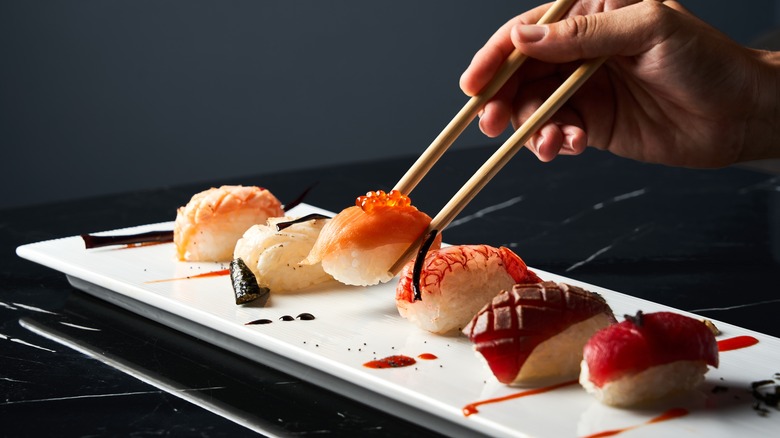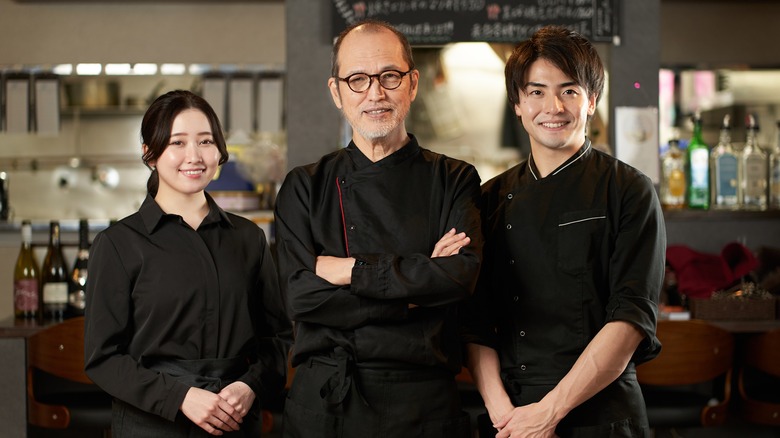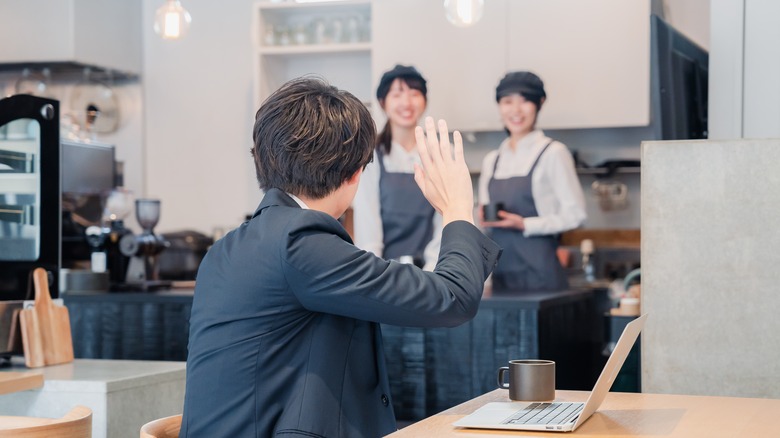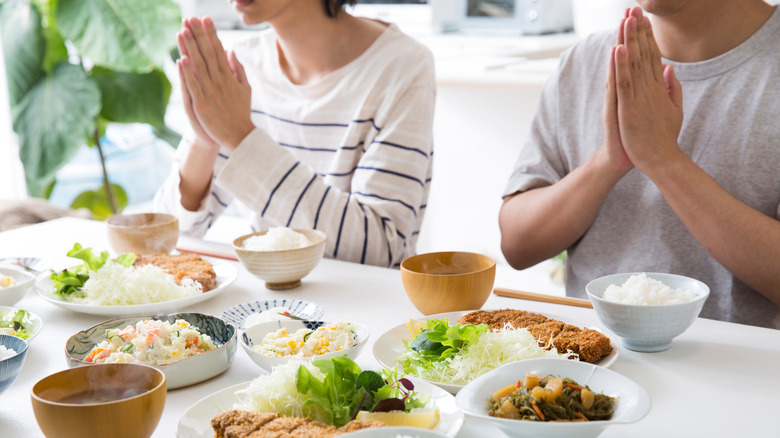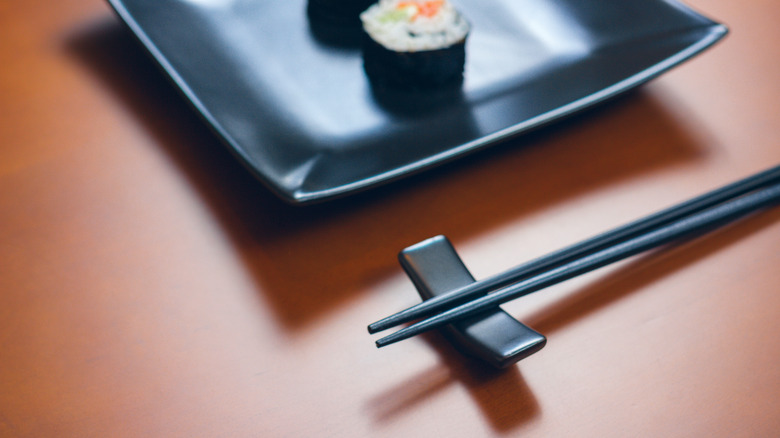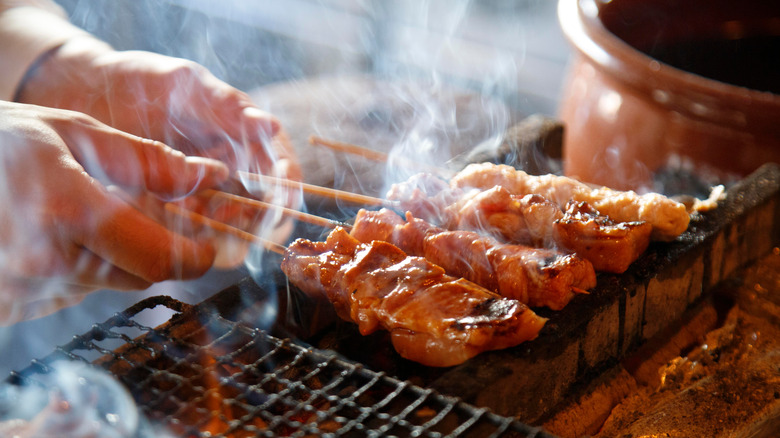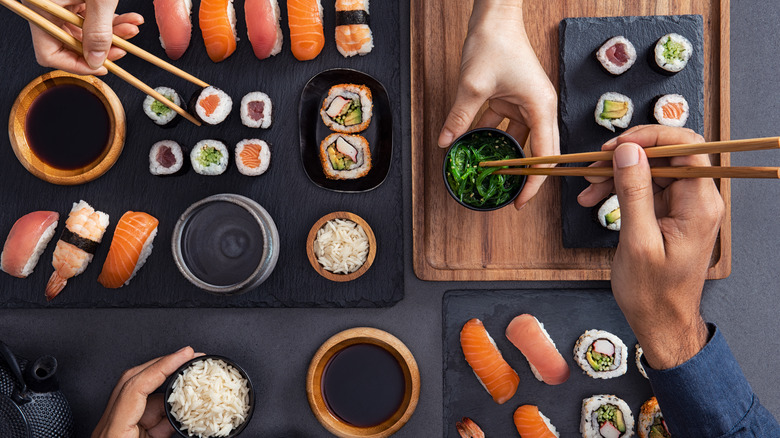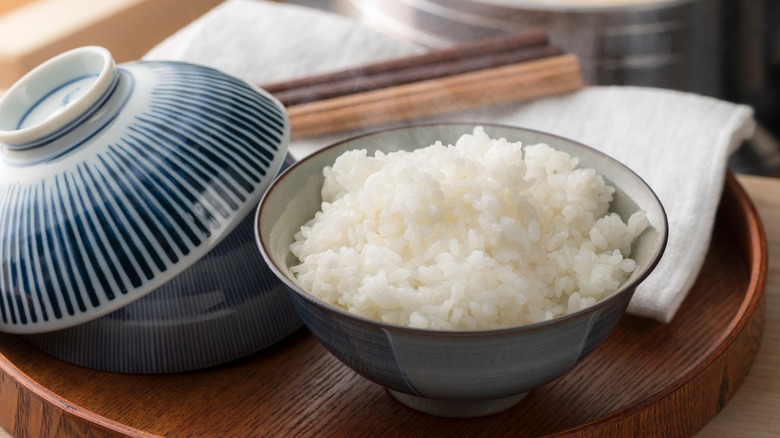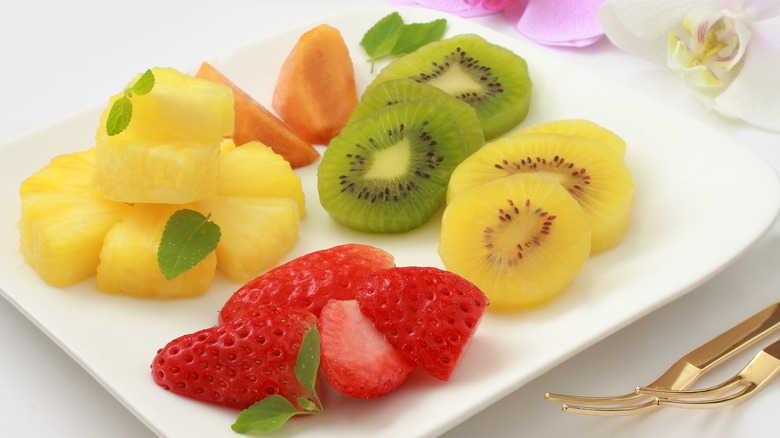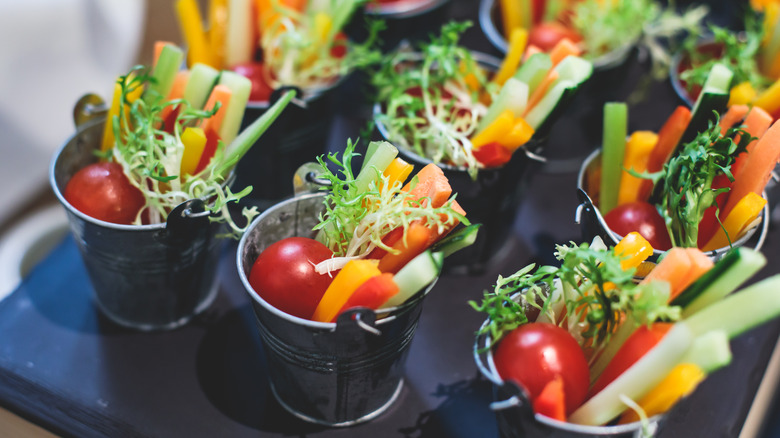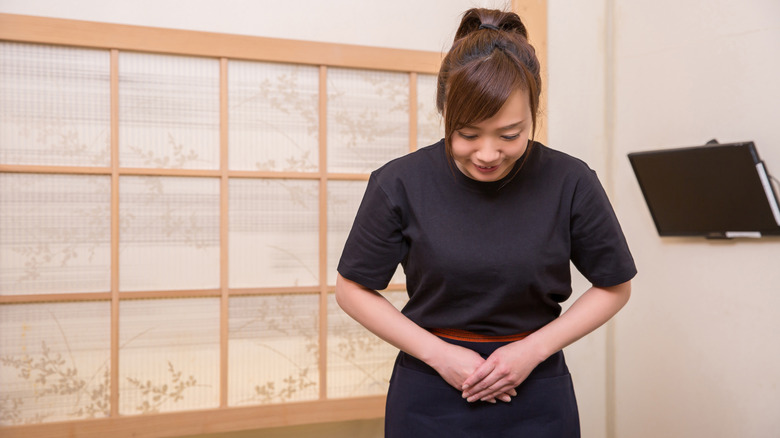Essential Words And Phrases To Know At A Japanese Restaurant
Immersing yourself in the culture of a restaurant always makes for a more authentic experience. This is especially true for a Japanese restaurant, as there are many traditions and customs to learn. If you have never eaten at a Japanese restaurant, you may be hesitant about the language barrier, but there is no reason to be. Whether you are visiting Japan, or you're dining locally, learning essential words and phrases will help you navigate the menu and allow you to have meaningful interactions with the staff.
From saying hello to learning the many ways to express thank you, understanding the language and customs of a Japanese restaurant will enhance your communication, and allow you to form a connection with those around you.
So, let's delve into these essential Japanese words and phrases — and the next time you're at a Japanese restaurant you'll dine with confidence while showing respect and appreciation for the language. The staff will be grateful for your efforts.
Konnichiwa — Hello
Upon arrival at a Japanese restaurant, you will likely be warmly welcomed with the greeting "Irasshaimase!" This expression, meaning "welcome to the business," is a common and polite way to greet customers in shops and restaurants throughout Japan. Rather than repeating this back to the staff, which wouldn't be necessary or expected, it would be appropriate to reply "Konnichiwa," which means hello or good day.
It's worth noting that different greetings may be used in Japan depending on the time of day. While in English, we tend to use "hello" regardless of the time, if it is before noon, in Japan, they would be more likely to say "ohayō gozaimasu," which means "good morning," though it translates literally as "it's early."
Similarly, if you are greeting someone after 6 p.m., it would be customary to use "konbanwa" for "good evening." This is traditionally only used once the sun has set, so it would be used later in summer than in winter.
While the staff will appreciate your efforts to choose the time-appropriate greeting, if you want to keep things simple, "Konnichiwa" is a perfectly acceptable greeting to use the whole day through.
O genki desu ka — How are you?
Once you have been welcomed into the restaurant and have exchanged hellos, you may wish to ask a member of the staff or your dinner companions how they are. The most formal way to ask this question is by saying, "O genki desu ka?" This phrase demonstrates a polite and respectful tone.
However, if you are in a more relaxed setting and know someone well, you can choose a more casual form of this question by simply asking, "genki?" This means the same thing but is less formal.
If someone asks you how you are, you can respond in several ways. One common phrase is "watashi wa genki desu," which means "I am fine." If you are feeling enthusiastic and positive, you can opt for "Zekkōchō desu" instead, which means "I am great."
Sumimasen — Excuse me
Once seated at your table, you may want to attract the attention of a waiter or other staff member. Interestingly, calling loudly for attention is perfectly normal in a Japanese restaurant. Even snapping your fingers, which would be considered rude in certain settings, is an acceptable way to let the waiter know you need attention. The staff understands and expects customers to actively seek their attention when required. In fact, in some restaurants, they even have buttons on the table to press for service.
To get their attention, use the phrase "sumimasen" which means "excuse me." The same word can also be used if you want to apologize. By saying "sumimasen" politely and raising your hand or making eye contact, you can effectively signal your desire for assistance.
Once you have the server's attention, here are some other phrases you may need:
"Kore wa nandesu ka" — "what is this?" If you are unsure what an item on the menu is, you can use this phrase to find out.
"Watashi wa bejitarian desu" — "I am a vegetarian, " or "watashi wa biigan desu" — "I am vegan." Most Japanese food is cooked in a fish or meat stock, so it is important to inform the server as early as possible if you don't eat animal products — then they can advise you which dishes will be suitable.
"[Food] arerugii ga arimasu" — "I am allergic to [specific food]." Another phrase that is very important to know and use as soon as you arrive at the restaurant.
Itadakimasu — Thank you for the food
Preparing to visit a Japanese restaurant is about more than just learning some phrases to communicate — it is also important to learn the traditions associated with eating a meal so as not to inadvertently offend anyone you are dining with or a member of staff. Before beginning to eat your meal, it is customary to give thanks by saying "Itadakimasu." This is similar to saying grace, but the Japanese thank everyone involved in the food's journey to your table. This includes the farmers or workers who provided the food, the chef who cooked it, and the waiting staff who served it. It even includes the animal or plant which has given itself up to be on your plate.
It is traditional to bring your hands together in a gesture of appreciation when saying "itadakimasu" and for everyone eating at the table to say it in unison. Even when dining alone, individuals in Japan often say "itadakimasu" as a personal acknowledgment and expression of gratitude.
Another phrase that may be said before the meal is "meshiagare," which means "enjoy your meal" or "bon appetit." This can be said to other people dining at the table or by a chef or waiter as they serve your food. "Meshiagare" serves as a warm invitation to savor the meal that has been presented.
Items you may find in a Japanese restaurant
If you are relatively new to Japanese cuisine, you may encounter certain items or practices during your meal that are unfamiliar to you. Here are two common elements that you may come across: Hashioki — chopstick rest. Chopsticks are, of course, a quintessential part of eating Japanese food. Understanding the etiquette surrounding their use is not only respectful but also enhances the overall dining experience in a Japanese restaurant.
When taking a break from eating, you should rest your chopsticks in the "hashioki" rather than on the table (via Japan Living Guide). The hashioki serves as a clean and hygienic resting place for your chopsticks. Similarly, when you have finished your meal, it is considered proper etiquette to place your chopsticks neatly back in the hashioki to show that you are done.
In a Japanese restaurant, it is common to be presented with an "oshibori" (warm towel) — it is often delivered on a tray and will likely be offered before and after the meal. The primary purpose of the oshibori is to freshen up your hands. It is considered rude to use it on your face, though you may see people doing so. Be sure to unroll your towel gently and fold it neatly beside you when finished — and never use it to wipe the table.
Menu items — Meat
It's essential to understand the names of basic foods at a Japanese restaurant. Here are words and phrases for common meats and the dishes which often include them. Chicken ("toriniku") is a popular meat in Japan, and you will see lots of toriniku dishes on most menus. A popular Japanese chicken dish is yakitori, which consists of grilled chicken on a skewer. It can be made from various chicken parts, including wings or thigh meat, and is coated in a glaze made from soy sauce.
The Japanese word for beef is "gyuuniku." Some of the most famous beef in the world comes from Japan, including Kobe and Wagyu, both known for being exceptionally high quality and incredibly tender. You will find many beef dishes on the menu in a Japanese restaurant. A popular dish is gyudon which is a comforting bowl of rice topped with thinly sliced beef, onions, and a tasty sweet soy sauce. It is a hearty and satisfying dish commonly enjoyed for lunch or dinner.
One of the standout pork ("butaniku") dishes in Japan is tonkatsu. These breaded pork cutlets have a delightfully crunchy exterior and soft, tender middle. It is often served with a sweet and sour sauce, shredded cabbage, and rice.
Menu items — Fish
Japan is famous for its fish, with sushi being one of the most celebrated dishes in the world. The Japanese word for fish is "sakana" and it is usually served as sushi or sashimi. Though both dishes contain raw fish, they differ in preparation and presentation.
Sushi is a visual masterpiece that combines raw seafood with tightly packed rice and accompaniments such as wasabi and pickled ginger. Sashimi, on the other hand, is simply sliced raw fish served with no accompaniments to allow the flavor of the fish to shine through.
Both sushi and sashimi are often made with tuna or salmon but can be made with any fish.
Another popular Japanese dish from the sea is "ebi," which means shellfish such as shrimp, lobster, or crayfish. In addition to being used in sushi and sashimi, ebi is often served as tempura. In this preparation, the shellfish is lightly coated in a batter made from flour and water, resulting in a delicate and crispy texture that perfectly complements the sweetness of the seafood.
Menu items — Accompaniments
Japanese cuisine offers a diverse range of accompaniments that beautifully complement main dishes and elevate the overall dining experience. Here are a selection of side dishes you may come across in a Japanese restaurant.
Rice ("gohan" in Japanese) features heavily in Japanese cuisine and is served alongside various meat, fish, and vegetable dishes. Rice bowls, known as "donburi," are a typical Japanese comfort food, mixing soft, fluffy rice with meat or vegetables in one delicious, satisfying bowl.
Noodles are another popular accompaniment in Japanese cuisine, with several types available. Udon noodles, made from wheat flour, are thick and chewy and can be enjoyed in a soup or stir fry. Soba noodles, made with naturally gluten-free buckwheat flour, offer a nutty flavor and are often served cold with dipping sauce or in a hot broth.
Although rice and noodles take center stage in the carbohydrate section of Japanese cuisine, bread ("pan" in Japanese) products can still be found on the menu. From "shokupan," which is a slightly sweet white bread, to "chocopan," a chocolate-filled bun, there is a wide selection of bread and pastries to satisfy any craving for baked goods.
Menu items — Fruit
With a solid dietary emphasis on health in Japan, fruits play an important part in Japanese cuisine. They can be found as part of meals or as standalone dishes. Here are a selection of fruits that you may want to order.
"Ringo" is the Japanese word for apple — these apples are typically larger than Western apples, so they are often chopped and peeled before serving and are rarely eaten whole as a snack. They are often eaten raw, but you may come across them in the form of a whole apple pie known as Kininaru Ringo, which consists of a whole Fuji apple coated in a thin pastry.
The Japanese word for pear is "Nashi." Similar in flavor to Western pears, Nashi are round rather than the pear shape we are familiar with in the United States. To conclude your meal on a fresh note, look for a "nashi sorbet" on the menu. This sorbet showcases the flavor of the fruit, providing a delightful and palate-cleansing finish to your dining experience.
"Mikan" (orange) are a variety of seedless Japanese mandarin orange with a sweet, citrusy flavor. Mikan jelly is a popular dessert in Japan, allowing you to have a refreshing dessert to finish your meal.
Menu items — Vegetables
Vegetables feature prominently in Japanese cuisine, and most meals contain a variety of fresh produce. Here are some vegetables you may encounter in a Japanese restaurant.
"Ninjin" is the Japanese word for carrots — they are a popular vegetable in Japanese cooking and feature in many dishes, either raw or cooked. "Namasu" is a fresh and vibrant salad containing finely sliced raw carrots and daikon radish, served with a tangy dressing.
The word for cabbage is "Kyabetsu." Cabbage is an adaptable vegetable that is used widely in Japanese cooking. You may also see "hakusai" on the menu, which is a particular variety of cabbage native to Asia. It is often seen in a stir-fry, where it retains its crunchy texture — or it's braised until soft and tender.
"Mame" means beans – Japanese mame are a staple ingredient that offer a range of flavors and texture to dishes. One variety that have become popular in the west in recent years are edamame, which are young soybeans. Often served steamed as an appetizer in Japanese restaurants, these addictive beans are enjoyed by popping them out of their shells, creating a fun and delicious snacking experience.
Menu items — Drinks
Drinks set the tone for your dining experience, so why not make a memorable impression by confidently ordering your preferred beverage? Use the phrase "o kudasai" which means "please give me," and add the drink of your choice in front of it. Here are a few options you may wish to order.
Water ("mizu") may already be on your table when you sit down, but if not, it is perfectly acceptable to order tap water when the waiter arrives to take your drink order. And "ocha" is Japanese for tea. Tea is a very popular drink in Japan, and many varieties are available, including the renowned matcha. Be aware that tea is served in handleless cups, so you will need to use two hands to lift the cup to your mouth.
The Japanese word for coffee is "Koohii." Although tea is more popular, coffee is widely enjoyed in Japan and will be available to order in restaurants. Classic variations such as espresso, cappuccino, and latte will appear on most menus.
Japanese sake = "Nihonshu." To immerse yourself in Japanese culture, why not order sake or nihonshu to drink with your appetizer? This fermented rice beverage has a nutty flavor and is a symbol of celebration and tradition in Japan.
Arigato — Thank you
Throughout your meal, you will likely want to say thank you numerous times and to different people. There are several ways to say thank you in Japan, so let's look at which ones to use in particular situations.
The standard polite form of thank you is "arigato gozaimasu," which you will use most often. This is the most respectful way to express your gratitude and should always be used for strangers and people who are older than you.
If the person you are speaking to is a friend or family member, you may use the more casual expression "arigato." However, if you want your gratitude to be more emphatic, you can say "Domo arigatou gozaimasu," which means "thank you very much."
The above phrase can be used throughout the meal — however, at the end of dinner, there is an important tradition to be observed. Saying "gochisousama deshita" to those who have provided your food will show that you are grateful for all the effort that went into it. If you do not express your gratitude in this way, the staff may be offended.
You can say "gochisousama deshita" at any point after the meal when speaking to the wait staff, restaurant owner, or if you happen to see a chef. They will be grateful to hear that you have enjoyed your meal.
Bowing is still considered a sign of respect in Japan, so you can bow your head slightly while using these expressions to further show your gratitude.
Sayonara — Goodbye
While "sayonara" is a familiar Japanese phrase, it is best not to use it when leaving a restaurant. Sayonara does mean goodbye, but in a much more permanent sense, if you are unlikely to see someone again (via Live Japan). There are better options for a more casual situation, similar to "see you later" in English.
"Mata chikaiuchini o ai shimashou" or simply "mata ne" can be used as a casual goodbye, meaning see you soon. These expressions convey a sense of anticipation for future encounters.
Alternatively, you can use another form of thank you as you leave the restaurant. "Iroiro arigato gozaimashita" means, "Thank you for everything," and would be a polite way to show your gratitude to staff as you leave the restaurant.
You can accompany your farewell with a nod, bow, or a smile as a gesture of appreciation. By using these culturally appropriate expressions, you can exit the Japanese restaurant on a positive note, showing your gratitude and leaving a lasting impression.

